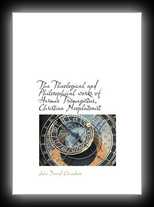
The Theological and Philosophical Works of Hermes Trismegistus, Christian Neoplatonist
by John David Chambers, M.A., F.S.A.
1882
Mercurius or Hermes Trismegistus of legend was a personage, an Egyptian sage or succession of sages, who, since the time of Plato, has been identified with the Thoth (the name of the month September) of that people. This Thoth is the reputed author of the Kitual of the Dead, or, as styled in Egyptian phraseology, the Manifestation of Light to the Soul, who through it declared the will of the Gods and the mysterious nature of Divine things to Man.1 Dr Pietschmann, in his work on Hermes, which exhaustively treats of this subject,2 gives a list of authorities for these facts, ranging from Plato down to Syncellus, circa A.D. 790. He states, however (p. 33), that by the time that the so-called Hermeneutical writings were collected together, the identity of Hermes with Thoth was forgotten, and Thoth became his son Tat, and Asclepius his disciple, both of whom he instructs in the writings now translated. Subsequently Pietschmann informs us, quoting Letronne,3 that the epithet Trismegistus appears first in the second century of the Christian era, and that, before that period, Hermes was designated by the repetiA1 tion of the peyas, ft eyas, neya; only, as on the Eosetta Stone. He was considered to be the impersonation of the religion, art, learning, and sacerdotal discipline of the Egyptian priesthood. He was, by several of the Fathers, and, in oi-7 TJ 1R awlinson s Egypt, i. 136, and the authorities there quoted. 2L eipsic, Engelmann, 1875, pp. 31-33. 3I bid. p. 35, Inscription Grecque de Rosette, Letronne, Paris,
(Typographical errors above are due to OCR software and don't occur in the book.)
Moses, and to have obtained the appellation of Thrice greatest from his threefold learning and rank of Philosopher, Priest, and King,1 and that of Hermes, or Mercurius, as messenger and authoritative interpreter of divine things. In the Hiero, 0glyphics he, like Horus, is represented by a bird with a hawks head, and to him was sacred the I bis and the Moon. This Hermes and there was but one among the ancient Egyptians8 was worshipped as a god by them. Tertullian4 says, In ancient times most authors were supposed to be, I will not say god-like, but actually gods; as, for instance, the Egyptian Hermes, to whom Plato paid very great deference Clement of A lexandria6 writes, Hermes of Thebes and Esculapius of Memphis ex vate Dcus; and he subsequently gives a detailed account of his works, forty-two in number four of astrology, others of astronomy, geology, and hieroglyphics, and thirty-six of philosophy, hymns to God, religious ceremonies, and sacerdotal discipline.0 Lactantius7 expresses himself thus (quoting Cicero, De Natura Deorum, Lib. iii.): Although a man, he was of great antiquity, and built Hermopolis, and is there worshipped as well as at Pheneus. He was most fully imbued with every kind of learning, so that the knowledge of many subjects and arts acquired for him the name of 1S ec the edition of the works of Hermes by Francois de Foix, Comte de Candalle, assisted by the younger Scaliger. Champo Uion the younger (P antheon Egyptien ). Several hieroglyphical representations of him, under various Egyptian names, are given by Pietschmann, p. 1. See Pietschmann, ibid. pp. 35, 36. De A nima, ch. 2. Stromata, I., ch. 21, p. 380, Oxford Edition, Lib. vi., ch. 4, p. 757. The Ritual of the Dead vulgarly attributed to Hermes, as at present discovered, consists of three Books redivided into 23 portions and about 165 chapters. See Rawlinson s Egypt, L138. TL ib. L
(Typographical errors above are due to OCR software and don't occur in the book.)
